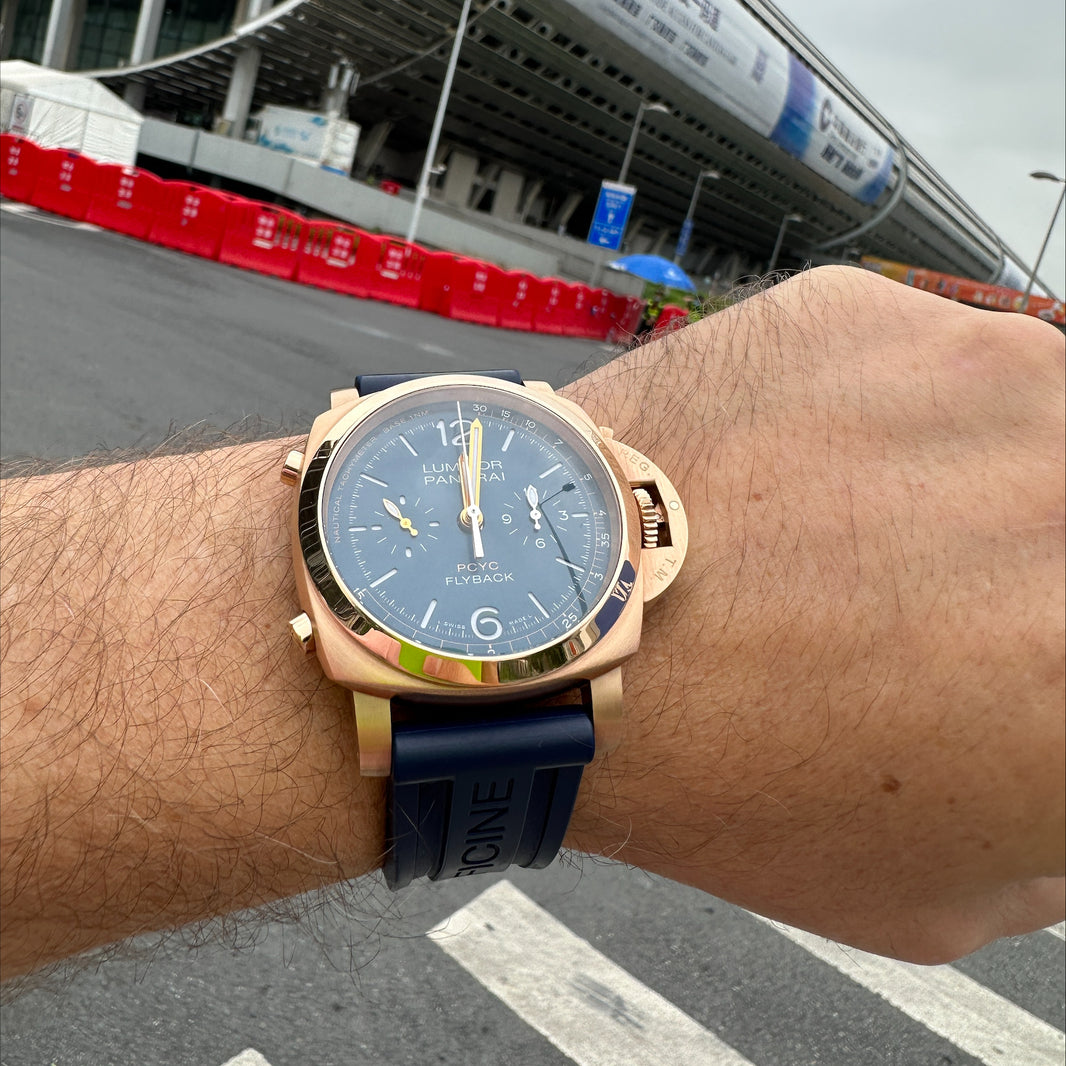We all like to collect watches for different reasons. Some of us enjoy the craftsmanship and heritage of high-end luxury watch brands. Others love to marvel at all the small gears and levers that give life to mechanical watches. In this post, we'll explore those technical marvels by explaining mechanical vs automatic watches.
Watch collectors, from beginners to veterans, often find themselves conflicted between tradition and modern technology. Some swear by the heritage of manually-wound mechanical movements, whereas others prefer the hassle-free use of automatic movements.
It’s important to note that when people talk about mechanical vs automatic watches, they usually refer to manual wind vs automatic movement. After all, any watch that is not quartz-powered is considered a mechanical watch.
So, what’s the difference between a mechanical and an automatic watch? Is one of them better than the other? And, how should you choose what type of movement to get?
If you want the answers to these questions, keep on reading!
Watch Movements Explained

You can categorize watch movements based on several different parameters. The most common one is how they get their power. That’s when you end up with two main categories: mechanical movements and quartz movements.
Mechanical Movements
Mechanical movements are very complex, as they consist of dozens of small components that need to work in unison to operate. The main parts of a mechanical movement are:
- The mainspring that stores the energy required to power the watch;
- A set of gears called a gear train, that transmits the energy from the mainspring to the balance wheel. It also facilitates the winding process and moves the hands of the watch when you set the time;
- The balance wheel that keeps the time through a harmonic oscillation;
- The escapement mechanism that holds the balance wheel in place and allows the gear set's periodic movement.
Quartz Movements
Quartz movements, on the other hand, have a much simpler operation. A small battery produces an electric current, which passes through a quartz crystal and creates vibrations. These vibrations keep the movement spinning and also move the hands of the watch.
The main advantage of quartz movements is their tremendous accuracy. Nevertheless, this precision is not necessary in modern times since most people have other means to tell time accurately, like their smartphones.
You can also categorize movements based on their different complications. Some watch movements will have a chronograph functionality. Others will have a perpetual calendar or a moon phase complication. And, of course, there are the high-end tourbillon movements.
Comparing Mechanical vs Automatic Watches
In general, mechanical or manual wind movements work a lot like automatic movements. They share the same essential components, and these components have the same functionality. However, there are some differences when it comes to mechanical vs automatic watches.
Winding
The most significant difference between the two types of movements is how you wind them. With a manual wind clock movement, you just turn the crown clockwise to wind the watch. The more you turn, the longer the watch will run. Be careful when you feel more resistance - it’s a sign that you need to stop winding to avoid damaging the movement.
Automatic movements, on the other hand, utilize an internal rotor that spins with the natural movement of your wrist. This energy is used to power the watch and is also stored up as a power reserve.
Most modern automatic watches also come with a manual winding feature. This way, you can have the best of both worlds; you can “charge” your watch when you wear it, and you can quickly give it some spins to power it up if you haven’t used it for a while.
Maintenance

Generally, all watches with a movement require servicing every 5-10 years, depending on how much you use them. Manual wind movements usually need more frequent services to ensure the crown's lubricants and gaskets remain in good condition.
On the other hand, automatic watches can run for many more years without servicing because they receive less daily stress. However, since they have more parts than a manual wind watch, their service can be more expensive.
Availability
If you’re particularly picky about your watch’s appearance, then your best bet is to look for automatic watches. They are much more abundant than manual wind watches. Manual wind movements are starting to become a relic of the past, and they can mostly be found in vintage or vintage-inspired timepieces.
Today, most modern timepieces will have an automatic movement with the additional manual wind function.
Reputation
Some watch collectors will tell you that you can only experience and appreciate the craftsmanship of watchmaking if you own a manual wind mechanical watch. Indeed, the history of manual wind watches is long since they were the first movements ever made.
But, this doesn’t mean you need to be attached to the past to appreciate a mechanical timepiece. While most manual wind calibers utilize delicate components and more exquisite craftsmanship, there are also some excellent automatic calibers.
Not to mention that even horological giants like Rolex and Patek Philippe use automatic movements for their watches. So, don’t force yourself to buy a manual wind watch just because it seems more crafty. Instead, look to buy a timepiece that you like and suits your needs.
Automatic & Mechanical Watches Through the Ages
Here are some historical automatic and mechanical watches that each signify an era change for the world of watchmaking:
First Mechanical Wristwatch

Photo from Patek Philippe Museum
Patek Philippe created the first-ever mechanical wristwatch for the Countess Koscowicz of Hungary in 1868 (at least, according to the brand). Back then, wristwatches were decorative jewelry pieces only worn by women. This timepiece had the shape of a bracelet and contained an in-house manual wind mechanical movement by Patek Philippe.
Since then, Patek Philippe has continued to produce high-quality manual wind mechanical calibers. Its pocket watches and some dress watches like the Calatrava come with these manual-wind movements.
First Automatic Watch

In 1923, John Hardwood established the first-ever automatic or self-winding movement patent. He achieved this with a small pivoting weight that moved back and forth according to the wearer’s motions. The first automatic watch, now known as the Hardwood “Bumper” watch, was released in 1928 with the help of Swiss watch manufacturer Fortis.
Rolex took inspiration from Hardwood’s design, improved it, and released its own automatic movement. The first Rolex automatic watch was the Oyster Perpetual, which was released in 1930.
First Automatic Watch Without A Rotor

Photo courtesy of Carl F. Bucherer
In 2008, Carl F. Bucherer produced one of the first-ever automatic movements without a traditional rotor. Until then, there had been several attempts to make a non-rotor automatic caliber, but Bucherer was the first to produce it on a large scale.
The CFB A1000 was present in several Carl F. Bucherer watches like the Patravi EvoTec. The movement utilizes a metal piece that moves on ball bearings around the periphery of the rest of the movement. This allows the movement to self-wind without the additional bulk of a standard rotor.
Are Automatic or Mechanical Watches Better?
This is a very common and simple question that doesn’t have a simple answer. In short, neither automatic nor mechanical watches are better than the other. They both contain the same basic components and serve the same functionality.
To decide which type of movement is best for you, you need to understand the minor differences between them and determine your personal needs.
Do you want an everyday timepiece to wear during the weekdays in the office and leave at home during the weekend? Then your best bet is most likely an automatic watch.
These watches usually come with large power reserves that will fill up throughout the week and won’t run out during the weekend. Then, you can pick it up and wear it on Monday morning without the need to mess with it.
Do you want a nice-looking thin dress watch to wear under a suit on formal occasions? Then you’ll probably need a manual wind mechanical watch.
Manual wind watches don’t have the additional weight and thickness that automatic watches have due to the winding rotor. Plus, since you won’t wear the watch often, winding it every time you need it shouldn’t be an issue.
You also need to consider the rarity of manual wind movements in modern timepieces. Watches with automatic Selita or ETA movements are abundant, whereas manual wind movements are mostly in-house and usually found in high-end timepieces.
Your best bet to find high-quality manual wind mechanical movements is to look into the vintage watch market, which poses its own risks.
Finally, consider if reliability and longer service intervals are vital to you. If the winding mechanism on a manual wind watch breaks, the timepiece will essentially not work. However, if the rotor in an automatic watch breaks, you’ll most likely still be able to wind it manually through the crown.
Also, due to the heavy usage and load on the threading of a manual wind movement, it will need more frequent service, which ups the total cost of owning one.
It’s a Draw!
Ultimately, the battle of manual wind mechanical vs automatic watches ends in a draw. Both movements will serve everyone just fine, and the choice essentially comes down to your preferences and needs. If you purchase a high-end luxury watch from a reputable brand, you’ll get an exquisitely-crafted movement regardless of its winding mechanism.
This exquisite craftsmanship that high-end luxury watch brands put into their timepieces drives us to produce the best watch rolls at Operandi Firenze. That’s why we rigorously test all our watch rolls to ensure their reliability, and craft them using only the best Italian leather. Consider purchasing one of our premium watch rolls to store your mechanical timepieces safely.
So, go out there, find your new watch (mechanical or automatic), and don’t forget to keep an eye on the time!








